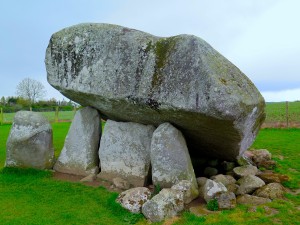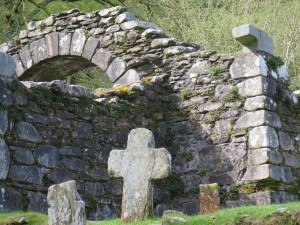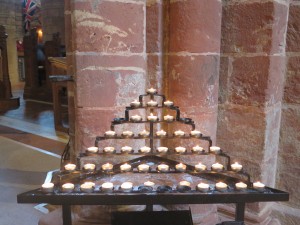 Just over a month ago, I turned to my husband and said, “I can’t imagine being part of a religious tradition where thousands of people die on pilgrimage.” The reports from Mecca every year touch a primal fear in me. I hate crowds. Even in high school and college I wouldn’t go to concerts because I don’t like feeling trapped, surrounded by people who are pushing and shoving. I grew up with the story of the Cocoanut Grove fire and it has made me forever edgy if I cannot see a clear exit and know that I can get out. When I check into a hotel, I count the doors from my room to the fire exit, so I can escape in an emergency, even if I am crawling at floor level. Just the thought of being crushed to death in a stampede makes me break out in a cold sweat.
Just over a month ago, I turned to my husband and said, “I can’t imagine being part of a religious tradition where thousands of people die on pilgrimage.” The reports from Mecca every year touch a primal fear in me. I hate crowds. Even in high school and college I wouldn’t go to concerts because I don’t like feeling trapped, surrounded by people who are pushing and shoving. I grew up with the story of the Cocoanut Grove fire and it has made me forever edgy if I cannot see a clear exit and know that I can get out. When I check into a hotel, I count the doors from my room to the fire exit, so I can escape in an emergency, even if I am crawling at floor level. Just the thought of being crushed to death in a stampede makes me break out in a cold sweat.
So reports of the tragedies at the Hajj are horrifying each time they are reported and every year seems to bring worse situations as larger and larger crowds attempt to fulfill this once-in-a-lifetime expectation of their faith. Each year, with increasing vehemence, other mideast nations (whose citizens have traveled to Mecca and Mina) insist that pilgrims should be safe, protected from the danger of tragedies such as the stampede this year that killed 4,200. And my fearful psyche emphatically agrees.
But my fear and horror at the statistics — which were particularly bad this year — invited me to notice (yet again) that my mind and heart were circling around the periphery of the real issue. Why we believe pilgrimages should be safe? They have never been safe in the past. When folks traveled to Santiago or Jerusalem from Britain or France during the Middle Ages, walking overland through foreign terrain where gangs of ruffians lay in wait to rob them (after all, the people who could afford to go on pilgrimage were the wealthy), or sailing through pirate-infested waters, or exposing themselves to disease and infection, many of them did not return.
The point of a pilgrimage is to die, after all. No, not necessarily physically and certainly not in any particular way (burned at the stake, suffocated, shot, crushed). But pilgrimage is about consciously letting the old ways, the old behaviors, the old person, die and a new, transformed life come into being. It is about releasing the broken aspirations, the worldly goals, the masks and personas that cling to unhealthy values. I don’t want to even hint at the suggestion that it was/is G-d’s will that this particular group of Muslim pilgrims were crushed to death by their fellow pilgrims during the ritual of Stoning Satan at Mina. I will never believe that, even if those who died might personally have said, “Insha’ Allah.”
 But I do think it is G-d’s hope that all creation – including humanity – shed what is worn out and restrictive and destructive, so that it may be continually reborn, renewed, refreshed, strengthened, empowered, made more whole, more holy, more real. I think it is G-d’s desire that, by becoming more expansive, we reveal ever more fully the beauty of the divinity within us. Buddhists call it enlightenment, attaining at-one-ment with the pulse and power of the universe, being absorbed fully into the flow of all Is-ness.
But I do think it is G-d’s hope that all creation – including humanity – shed what is worn out and restrictive and destructive, so that it may be continually reborn, renewed, refreshed, strengthened, empowered, made more whole, more holy, more real. I think it is G-d’s desire that, by becoming more expansive, we reveal ever more fully the beauty of the divinity within us. Buddhists call it enlightenment, attaining at-one-ment with the pulse and power of the universe, being absorbed fully into the flow of all Is-ness.
With Samhain just around the corner, it might be fruitful to consider the pilgrimage experiences of our own lives – whether literal and geographical, or more abstract and internal. It may be fruitful to reflect on the times when we voluntarily let go of some behavior or trait that was holding us in thrall. It might be important to think about how we lean into the process, and allow the familiar to fall away, to dis-integrate into real change outside our control. It may be fruitful to ponder the ‘who’ we have become in the past on the other side of those transformative moments and events.
Samhain is the season of dormancy when we pay attention to the bones of our life, the fundamental structure, the truest truth. It is the season of deep wisdom, the fundamental wisdom all the way down at the roots that nurtures us toward our development into Wise Elders. at whatever age that happens. It is the season that trains us to sit lightly even to what we think we know best about ourselves, even to the identity with which we feel most comfortable or of which we are most proud. It is the season that prepares us (through practice again and again) for our death out of this life into whatever experience comes next in whatever form that takes.
If you read Wednesday’s post, I would suggest that noticing the gifts and blessings of our selves, celebrating our strengths and our beauty, is one way of practicing the pilgrim’s discipline of letting go. Because our gifts and blessings only increase as we use them and give them away, they transform us as we share them generously. No gift or blessing remains a gift or blessing when it is hoarded. Not love or kindness or compassion or peace or wisdom or joy or hope or vision or… Every one of those distills into richer and richer essence in the giving and giving up.
It is never ‘safe’ to share a blessing. It will always change us irrevocably. But it is our vocation as human be-ings.
In the days remaining before October 31 (All Saint’s Eve) November 1 (All Saints Day) – part of the triduum of All Hallows – celebrated in Mexico as The Day of the Dead, it might be an interesting exercise to name the old selves that have died to make way for who we are in this moment, each of us morphing steadily into Wise (or Wiser) Elders. It might be an interesting exercise to ponder what we are prepared to give up this year to make way for the new.
It might be interesting to note that each day of life is a day of pilgrimage if we choose to make it so.
–Andrea
Text © 2015, Andrea La Sonde Anastos
Photos © 2015 Immram Chara, LLC
